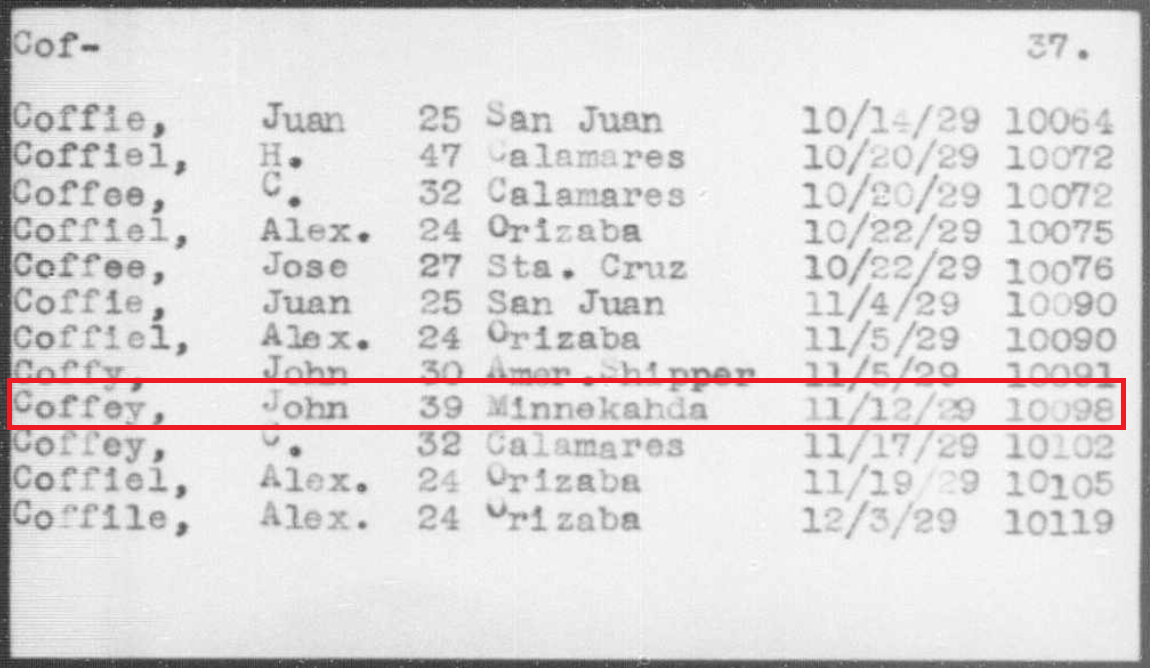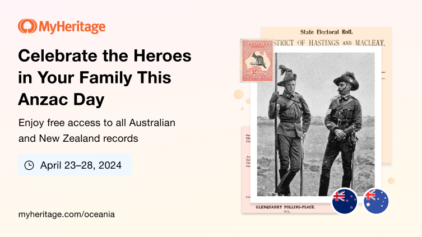Thanks for the outstanding efforts.


We are excited to announce that we have added 7,291,329 new historical records to SuperSearch™ during January 2019. Added collections are The 1940 Denmark Census; Philadelphia, Pennsylvania Passenger Lists, 1883-1945; and the Port of New York, Index to Discharged or Deserted Crew, 1917-1957.
Here is more information on these collections:
| Collection | Description | Number of Records | Exclusive to MyHeritage | Link to Search |
|---|---|---|---|---|
 1940 Denmark Census | The 1940 Denmark Census was conducted on November 5, 1940. It's the first Denmark Census where the majority of the information was filled out by the head of the family for each household and not by public census workers. | 3,950,454 records | Exclusive | Search collection now |
 Philadelphia, Pennsylvania Passenger Lists, 1883-1945 | Passenger manifests of ships arriving at Philadelphia, Pennsylvania, from 1883 through 1945. | 2,071,882 records | Not Exclusive | Search collection now |
 Port of New York, Index to Discharged or Deserted Crew, 1917-1957 | A card collection of alien crew members who deserted or were discharged from their vessel in New York City, New York. | 1,268,993 records | Not Exclusive | Search collection now |
1940 Denmark Census
With the addition of this collection, containing 3,950,454 records, we have completed our collection of all 20 Denmark Census record collections from 1787-1940 on SuperSearch!
In December 2014, we partnered with The Danish National Archives in an effort to index Danish census and church records spanning 1640-1930. Since then, we have made every effort to fulfill this obligation, and we can now officially announce that we have completed our promise to index all available Danish censuses, totaling 43.1 million records!
The 1940 Denmark Census was conducted on November 5, 1940, and provides a glimpse into the lives of the citizens of Denmark at the start of World War II. Every individual within the household at the time of the census, whether family, visitor, or employee was enumerated. Each record contains information about each specific person’s given and family names, gender, residence, birth date, birthplace, marital status, marriage date, and their relationship to the head of the household.
Additional information can be found on the images including profession, education level, and disability (hearing and vision impairment). The census was the only population registration taken in Denmark during World War II; the previous census was 1930 and the following census was 1950.
Following the German invasion on April 9, 1940, the government of Denmark faced an impossible situation. Unable to mount a reasonable defense, and facing certain annihilation by the German army, Denmark capitulated with little resistance. As a result of their quick surrender, and Denmark’s strong agricultural industry, Adolf Hitler considered Denmark a protectorate and allowed the Danish government to retain most of its autonomy. Critically, the police and judiciary remained under Danish control and King Christian X remained on the throne, becoming a symbol of resistance for the Danish people. While relations with the German government were strained, local and national affairs proceeded as normally as possible and the Danish government continued with the planned census in November.
The Faroe Islands, which had the status of a proper county of Denmark in 1940, and Greenland, a tightly-controlled Danish colony, do not appear to have participated in the 1940 Denmark Census due to their individual wartime statuses. Both territories were considered of high strategic and military value during World War II. The British occupied the Faroe Islands only four days after the German invasion of Denmark in April 1940 to prevent these important North Atlantic islands from becoming German military outposts. After the German invasion of Denmark, the United States exerted tremendous diplomatic pressure with the Canadians and British to hold Greenland as a neutral and American protectorate which lasted until the United States entered the war in December 1941.
The majority of the 1940 census information was recorded by individual householders, not government census workers. This is reflected in the images as you will see that each householder completed their own census packet, enumerating every individual currently residing in their home. Householders personally completing census forms leads to more variation in how the information was recorded, particularly in residence fields.
Census contain valuable information just waiting to be discovered, providing unique insight into the lives of your ancestors at the time. Families can be traced from each census to the next over years, and often from place to place throughout the country. A census can also lead to the discovery of new relatives. You can search for an ancestor and discover previously unknown additional family members or friends who lived in the same household.
Peter Vilhelm Glob, better known as P.V. Glob, is in the census. Glob was a famous Danish archaeologist and involved in Middle Eastern archaeology, where he headed several scientific expeditions. He was also the director of the National Museum in Copenhagen and the National Heritage Board.
In November 1940, when the census was taken, Glob had just become the father of a boy. The census was taken shortly after the birth, so his son did not even have a name yet. In the census, he was listed only as “boy”!
Search the 1940 Denmark Census
Philadelphia, Pennsylvania Passenger Lists, 1883-1945
This collection, with 2,071,882 records, contains the passenger manifests of ships arriving at Philadelphia, Pennsylvania, from 1883-1945. Information available varies due to significant changes to immigration laws during the span of this collection. The most common information available includes the passenger’s name, sex, age, date of arrival, and name of the ship. More detailed passenger manifests collected additional information including marital status, birth information (date and location), nationality, last residence, home city, port of departure, as well as the names and addresses of family members in the United States and home country.
At the turn of the 20th century, Philadelphia was one of the most important immigration ports in the United States, despite being more than 100 miles inland from the Atlantic Ocean. Immigration to Philadelphia began in earnest when the Pennsylvania Railroad helped form the American Line shipping company. The American Line carried passengers from Liverpool, England, to Philadelphia. During the 1880s, the American Line was offering as many as three sailings per week from Liverpool to Philadelphia. The Red Star Line, also with ties to Philadelphia, connected Antwerp, Belgium, to Philadelphia but sailed less frequently than the American Line.

The Washington Avenue Immigration Station, constructed in 1873 to process the waves of new immigrants into Philadelphia.
Philadelphia was a booming industrial complex with a demand for primarily skilled workers. Unskilled workers immigrating to Philadelphia from the Baltic or Eastern Europe would not settle in Philadelphia but immediately continued on to other cities throughout the United States with a higher demand for unskilled labor. Noting the importance of Philadelphia, both as an industrial center and a port of immigration, the Federal Government opened the National Quarantine Station, near Lewes, Delaware, in 1884. In 1893 the Federal Government opened another station at Reedy Island (some 45 miles south of Philadelphia). Eventually, passenger screening was consolidated to Marcus Hook in 1913 (20 miles from Philadelphia).
Noting the success of the American Line, larger shipping companies began to offer services from Europe to Philadelphia. In 1898, the giant Hamburg-America Line extended their Europe to Boston service, giving passengers the option to continue on to Philadelphia. Holland-America, Italia, and North German Lloyd lines all followed suit and began offering services from Europe to Philadelphia.
Immigration through Philadelphia peaked in the years prior to World War I, making Philadelphia the third most important immigration port in the United States by volume of passengers and a port of exceptional value to Jewish, Polish, and German immigrants. After World War I, the Immigration Act of 1924 set quotas and restrictions on immigration that brought an end to Philadelphia’s “Golden Era” of immigration.
Search the Philadelphia, Pennsylvania Passenger Lists
Port of New York, Index to Discharged or Deserted Crew, 1917-1957
This card collection of alien crew members who deserted or were discharged from their vessel in New York City, New York contains 1,268,993 records with over 100,000 typewritten cards with images. Information on these cards includes names of crew members, their ship, gender, age, and date of discharge or desertion.
Crew lists are a valuable source of information for genealogists who cannot find immigrants on passenger manifests. However, not all crew members who were discharged in New York City remained in the United States. Many crew members were discharged from one vessel and immediately joined another vessel departing New York City.
While it is apparent that some cards have names on both the front and back, unfortunately only one side was captured in the microfilm. The original cards were destroyed after the microfilm was transferred to the National Archives resulting in the loss of all information on the reverse side of some cards.
Found in this collection is a record for John Coffey, a fireman aboard many transatlantic passenger vessels, including the RMS Olympic, RMS Lusitania, and RMS Mauretania.

Record for John Coffey in Port of New York, Index to Discharged or Deserted Crew, 1917-1957 (click to zoom).
He gained worldwide notoriety in 1912 as “the luckiest man alive” after deserting from RMS Titanic in her last port of call in Ireland. He stowed away on a smaller boat used to load/unload the ship and hid with the mailbags destined for shore. Had Coffey remained aboard, he most likely would have died when the Titanic struck an iceberg and sank four days later. He said afterward that the reason he got off the ship was that he held a bad feeling about the voyage.
Search the Port of New York, Index to Discharged or Deserted Crew
Summary
All these newly updated collections are now available through MyHeritage SuperSearch™. Searching the records is free, although a MyHeritage Data subscription is required to view records and to save them to your family tree.
Our matching technologies have been unleashed on these records, and MyHeritage users will soon receive Record Matches through our technology that automatically finds relevant historical records for individuals in their family tree. Users can then save those matches and extract new information directly to their own tree.
Our Record Detective technology ensures that records point to even more records. Any single discovery will open up the door to new discoveries and lead you to new records that contain your relatives. All records show a list of additional records and people in family trees that are connected to the person you are looking at, as well as other people listed in the record.
We hope you enjoy searching the new records. Enjoy!












Mitja
February 12, 2019
Great. Now add something from Slovenia, Austro-Hungarian Empire, Yugoslavia…
Thanks